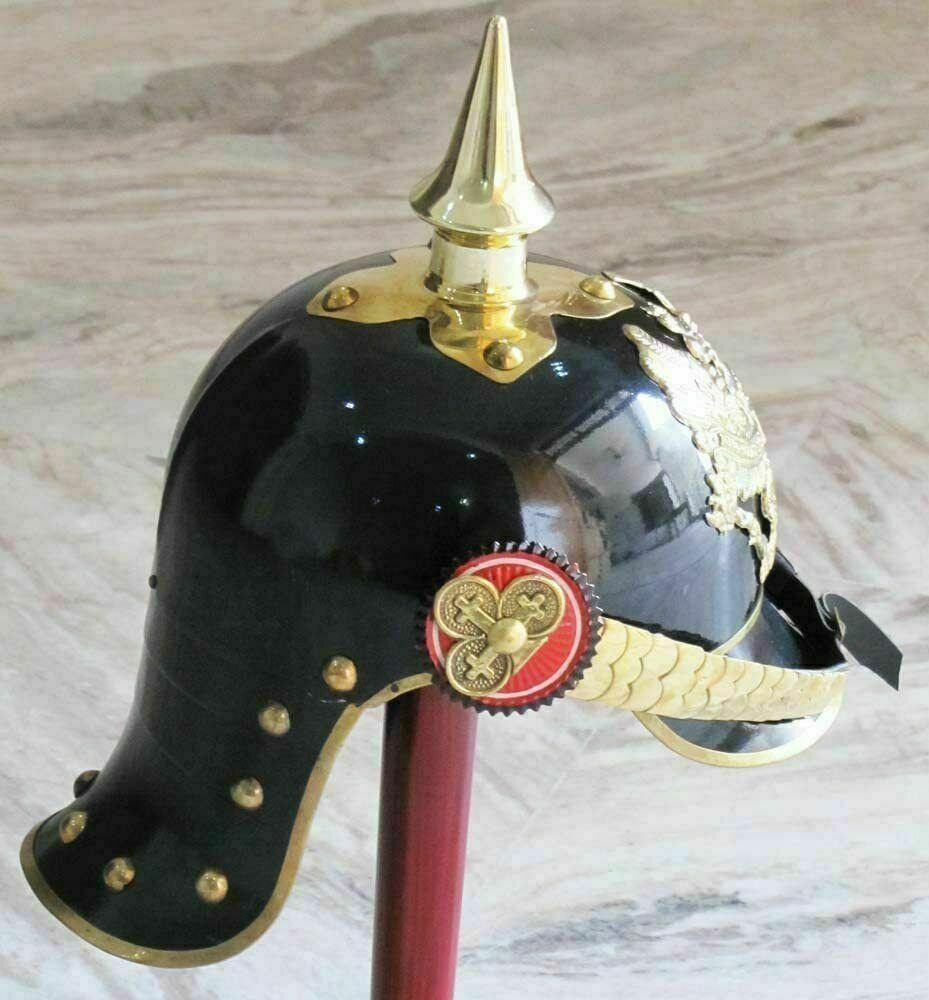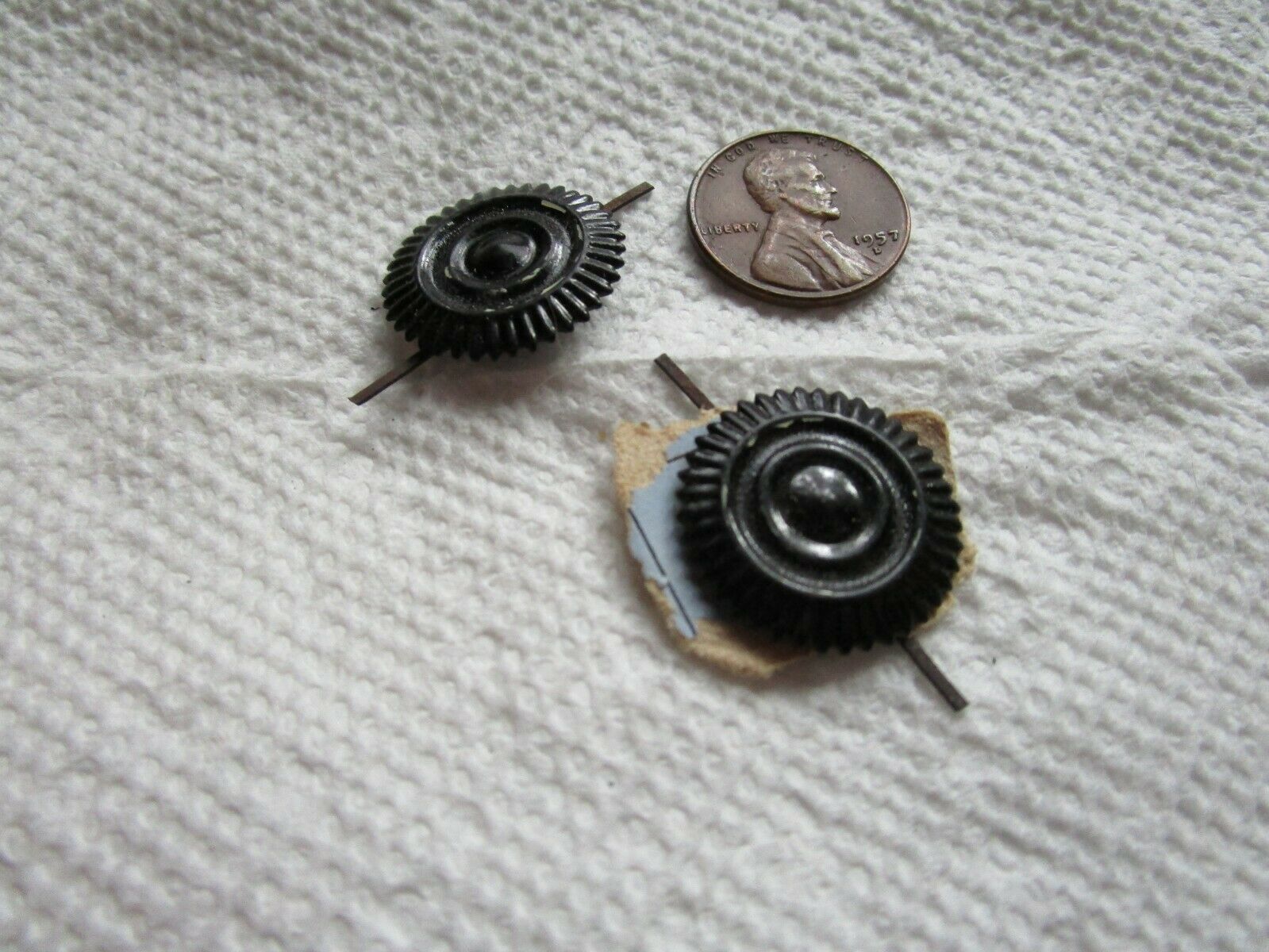-40%
1895-1914 Prussian Spiked Helmet Badge--VERY REAL THING --SEE STORE WW1-WW2
$ 58.07
- Description
- Size Guide
Description
PLEASE FOLLOW OUR E BAY STORESEE ALL PICS
SALE
SEE OUR STORE
PLEASE READ WHOLE ADD
LOOK AT SECOND PIC ,SCROLL DOWN
Imperial Germany
[
edit
]
Kaiser
Wilhelm II
reviewing Prussian troops, by
Carl Röchling
The
Imperial German Army
inherited much of the traditions and concepts of the Prussian Army, which was its largest component army. According to article 61 of the Imperial constitution, the Prussian military code was to be introduced throughout the
German Reich
.
[71]
The Bavarian, Saxon and Württemberg kingdoms continued to use their military codes. The conservative leaders of the army took an ever-increasing role in both domestic and foreign policies.
By the end of the 19th century, most Prussian officers could be divided into two groups: those who argued for boldness and self-sacrifice, and those who advocated technology and maneuver in order to minimize casualties.
[72]
First encountered during the
Franco-Prussian War
, new technological military innovations such as the
machine gun
increased the power of defensive units. For the Prussians, who advocated offensive operations, infantry attacks would risk becoming sacrificial assaults.
With regard to a possible future two-front war,
Alfred von Schlieffen
, the Chief of the General Staff from 1891–1906, had suggested a deployment scheme which became known as the
Schlieffen Plan
. Modified by
Moltke the Younger
, its intention of quickly defeating France proved impossible to achieve. In the actual event of the first world war; on the
Western Front
, the German advance stalled into
trench warfare
after the
First Battle of the Marne
. On the
Eastern Front
, however, the Prussian operations succeeded in encircling and smashing the Russians at
Tannenberg
. Though developing
infiltration tactics
as a way of re-introducing maneuver to modern warfare, they were unable to achieve a decisive breakthrough in their
German spring offensive
on the Western Front in the last year of the war, and the Germans lost the war of attrition.
The Imperial German Army was replaced after World War I with the volunteer
Reichswehr
of the
Weimar Republic
. Although the
Treaty of Versailles
attempted to disarm Germany, the
Reichswehr
discreetly maintained many of the traditions of the Prussian Army. The
General Staff
was camouflaged as a non-descript
Truppenamt
(troop office), while the War Academy was replaced with decentralized divisional schools.
[73]
Hans von Seeckt
, the head of the
Reichswehr
, designated the new military's battalions as successors of the traditions of Prussian regiments.
[74]
During the
interwar era
, German officers contemplated how to apply maneuver warfare after the experiences of the
Great War
. Innovations in
armor
and
airpower
were adopted to infiltration tactics, resulting in the doctrine known as
Blitzkrieg
.
[75]
[76]
Characteristics
[
edit
]
Since the 17th century, the army of Brandenburg-Prussia was characterized by its initiative, maneuverability, and aggressive command at the
operational
level of war. The Hohenzollern state often had fewer resources and manpower than its rivals, and thus the Prussians focused on quickly achieving a decisive victory to avoid a war of attrition.
[77]
The Prussians practiced what became known as
Bewegungskrieg
, or
war of movement
, in an attempt to
strike at the flanks
or rear of the enemy.
[78]
The Prussian emphasis on decisive battles instead of wars of attrition led to its being inexperienced in
siege warfare
, at which the Prussians have been considered incompetent.
[79]
The Great Elector
practiced many of the concepts applied to the Prussian Army in later centuries, including flank attacks at
Warsaw
and, at
Fehrbellin
, the willingness to attack when outnumbered.
[80]
The elector advocated campaigns that were "short and lively".
[81]
During the 1740s, Frederick the Great issued a series of new regulations and documents regarding his army's experiences during the first two Silesian wars and how they would relate to future wars. The doctrines he espoused focused on speed and offense. Lighter and faster cavalry were preferred over heavy cavalry; while hussars were treated as luxury troops by Frederick William I, his son made them an integral part of the army. The artillery was to use light three-pound guns which made up for their lack of power with versatility.
[82]
After being outmaneuvered by the Austrians in the Second Silesian War, Frederick began emphasizing an overwhelming attack instead of a war of attrition. Rather than frontal attacks, the Prussian king tried to apply the
oblique order
, by which his army's strongest wing was focused against the enemy's weakest wing or flank, while restraining his own weaker wing.
[83]
Frederick the Great summed up the Prussian style of war at
Leuthen
, advocating an attack on the enemy "even if he should be on top of the
Zobtenberg
".
[84]
The Prussian emphasis on attack was well-ingrained in its officer corps.
Flies
unsuccessfully went on the offensive in the
Battle of Langensalza
, despite being outnumbered by the Hanoverians and having
Falckenstein's
troops nearby.
[85]
Similarly,
Kirchbach
was willing to endure excessive casualties at
Wörth
without waiting for reinforcements.
[86]
Moltke wanted a quick campaign in
Bohemia
against Austria so that Russia or France would not become involved in the Austro-Prussian war. Although Moltke considered Prince
Frederick Charles
' march through Bohemia to be too slow,
Hans Delbrück
found the "Red Prince's" eventual attack at
Königgrätz
to have been in the Prussian tradition, "which, by daring to lose a battle, wins it".
[87]
Otto von Bismarck
, a civilian, wearing a cuirassier officer's metal
Pickelhaube
The Prussian-style war of movement and quick strikes was well-designed for campaigns using the developed infrastructure of Western and Central Europe, such as the
wars of unification
, but failed when it was applied by the
German Army
to the
Soviet Union
and
North Africa
.
[88]
The Prussian and later German systems were regarded as weak in
intelligence
,
counterintelligence
, and
logistics
, but during the First World War the German Army was often able to lay its hands on British and French battleplans. If the enemy successfully endured the initial operational attacks, the Prussian system had great difficulty in
Stellungskrieg
, or
war of position
, though during the First World War those were not as pronounced.
The Prussian Army is often considered to have used the flexible command of
Auftragstaktik
(mission tactics), by which subordinate officers led using personal initiative. This developed out of the relationship between the
Junker
aristocracy, who made up most of the officer corps, and the monarchy. In return for political support from the nobles, the monarchs granted them greater privileges on their estates and greater initiative on the battlefield. According to the theory of
Auftragstaktik
, the commander would issue a mission to his subordinate officers, who were to pursue the directive as they saw fit. Gneisenau was an early proponent of
Auftragstaktik
,
[89]
and Moltke interpreted the theory as "the higher the authority, the shorter and more general" the orders;
[90]
considerable leeway was granted to subordinates in order to pursue the goal.
[91]
19th-century historians saw
Leuthen
as one of the best examples of
Auftragstaktik
[92]
and an early example of
combined arms
.
[93]
Often stereotypically associated with the Prussian Army was the
Pickelhaube
, or spiked helmet, in use in the 19th and early 20th centuries. Victorious battles were celebrated through
military marches
, such as the
Hohenfriedberger Marsch
, allegedly written by Frederick the Great after
Hohenfriedberg
, and the
Königgrätzer Marsch
, by the march composer
Piefke
. The Prussian
Großer Zapfenstreich
military tattoo is still in use by the modern
Bundeswehr
. The
Iron Cross
was adopted by the German Empire and its successor states, and is also still used as a symbol of the
Bundeswehr
.













